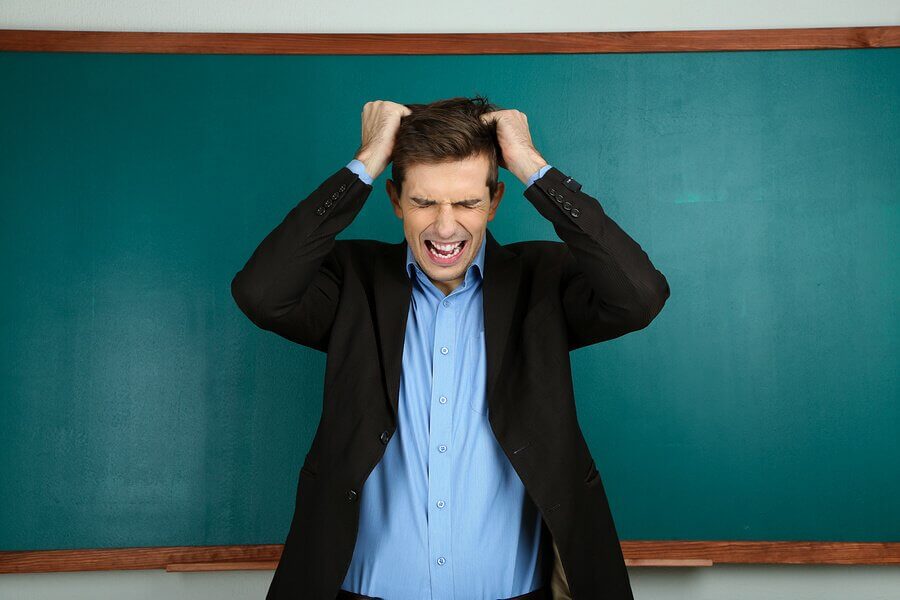Common Characteristics of Poor Teachers

In today’s article, we want to expose the characteristics that commonly identify poor teachers. There are false beliefs among many educators that being hard on students is the right way to get students to learn better. But nothing could be further from the truth.
The harsher teachers are, the less their students pay attention to them. In fact, students even become fearful, producing conflict that will affect their future.
Unfortunately, this almost military-style of teaching still exists among many educators, and does nothing to create a positive learning experience.
Poor teachers always…
Look to assign guilt and arouse a sense of fear
These educators like to expose the failures of students and even ridicule them. They also tend to inadvertently produce poor behavior in their students, reducing their ability to learn.
Students’ fear grows even more in the face of questioning. This is especially true when a student feels he or she may make a mistake in answering the teacher’s question.
As a result, children develop a certain level of distrust, making them more reluctant to participate in class out of fear of making a mistake.
Discover: The 7 Most Common Myths About Education
Discourage participation, and don’t conduct continuous evaluation
Poor professors never take into account the participation of their students. They always want to have complete and absolute control of the class, refusing to provide additional explanations when a student wants to go deeper on a certain topic. According to these educators, doing so would only cause unnecessary delays.
It’s also common for these teachers to overlook efforts and attitudes that students adopt in order to improve their academic performance. Rather, they base their grading only on test performance.

Blame students for overall poor performance
Poor teachers never stop to think about why the majority of their students are getting bad grades. Rather, they simply assume that poor performance is the result of the students’ lack of interest in the subject matter. These educators never ask themselves what their own role in all of this might be.
Refuse to take the time to bring themselves up to date
Poor teachers never update their teaching techniques or materials. They don’t care about staying up to date on new technology or pedagogical trends. What’s more, many refuse to allow their students to use these same modern and advanced resources.
Want to be in charge
Some teachers believe that keeping a certain distance from their students puts them at a supposed advantage because students see them as authority figures.
However, experts say that teachers who come to form closer relationships with their students earn more respect and admiration in return. What’s more, they provide their students with a level of trust and security that lasts for the rest of their lives.
Avoid going in depth
Poor educators only care about teaching their students the basics and, therefore, only touch the surface of subject matter. And because of the fear these teachers instill, their students are unable to ask for more adequate explanations.

Dislike children
A good teacher needs to have a certain degree of empathy with each and every student and tries to make the class enjoyable. But, why is it that some teachers don’t even like children?
- In elementary school, some teachers are intolerant of the typical shouting and commotion of children this age.
- In high school, teachers may become frustrated with students who are unable to pay attention or are more interested in other things.
- Many college professors become demotivated because of low salaries, meaning they must make greater sacrifices for fewer rewards. If the motivation isn’t there, the consequences are clear.
To summarize, poor teachers have a general lack of commitment towards their students and many weaknesses in regard to their knowledge.
In today’s article, we want to expose the characteristics that commonly identify poor teachers. There are false beliefs among many educators that being hard on students is the right way to get students to learn better. But nothing could be further from the truth.
The harsher teachers are, the less their students pay attention to them. In fact, students even become fearful, producing conflict that will affect their future.
Unfortunately, this almost military-style of teaching still exists among many educators, and does nothing to create a positive learning experience.
Poor teachers always…
Look to assign guilt and arouse a sense of fear
These educators like to expose the failures of students and even ridicule them. They also tend to inadvertently produce poor behavior in their students, reducing their ability to learn.
Students’ fear grows even more in the face of questioning. This is especially true when a student feels he or she may make a mistake in answering the teacher’s question.
As a result, children develop a certain level of distrust, making them more reluctant to participate in class out of fear of making a mistake.
Discover: The 7 Most Common Myths About Education
Discourage participation, and don’t conduct continuous evaluation
Poor professors never take into account the participation of their students. They always want to have complete and absolute control of the class, refusing to provide additional explanations when a student wants to go deeper on a certain topic. According to these educators, doing so would only cause unnecessary delays.
It’s also common for these teachers to overlook efforts and attitudes that students adopt in order to improve their academic performance. Rather, they base their grading only on test performance.

Blame students for overall poor performance
Poor teachers never stop to think about why the majority of their students are getting bad grades. Rather, they simply assume that poor performance is the result of the students’ lack of interest in the subject matter. These educators never ask themselves what their own role in all of this might be.
Refuse to take the time to bring themselves up to date
Poor teachers never update their teaching techniques or materials. They don’t care about staying up to date on new technology or pedagogical trends. What’s more, many refuse to allow their students to use these same modern and advanced resources.
Want to be in charge
Some teachers believe that keeping a certain distance from their students puts them at a supposed advantage because students see them as authority figures.
However, experts say that teachers who come to form closer relationships with their students earn more respect and admiration in return. What’s more, they provide their students with a level of trust and security that lasts for the rest of their lives.
Avoid going in depth
Poor educators only care about teaching their students the basics and, therefore, only touch the surface of subject matter. And because of the fear these teachers instill, their students are unable to ask for more adequate explanations.

Dislike children
A good teacher needs to have a certain degree of empathy with each and every student and tries to make the class enjoyable. But, why is it that some teachers don’t even like children?
- In elementary school, some teachers are intolerant of the typical shouting and commotion of children this age.
- In high school, teachers may become frustrated with students who are unable to pay attention or are more interested in other things.
- Many college professors become demotivated because of low salaries, meaning they must make greater sacrifices for fewer rewards. If the motivation isn’t there, the consequences are clear.
To summarize, poor teachers have a general lack of commitment towards their students and many weaknesses in regard to their knowledge.
All cited sources were thoroughly reviewed by our team to ensure their quality, reliability, currency, and validity. The bibliography of this article was considered reliable and of academic or scientific accuracy.
- Alcívar M, V., Cornejo A, N., & Izquierdo J, G. (2017). Docentes y estudiantes, la brecha generacional digital. Espirales Revista Multidisciplinaria de investigación, 1(7). Recuperado de: https://revistaespirales.com/index.php/es/article/view/228
- Bernal A., & Ibarrola S. (2015). Liderazgo del profesor: objetivo básico de la gestión educativa. Revista Iberoamericana de educación, 67, 55-70. Recuperado de: https://redined.educacion.gob.es/xmlui/bitstream/handle/11162/176939/v.67%20p%2055-70.pdf?sequence=1&isAllowed=y
- Edwards D. (1990). El papel del profesor en la construcción social del conocimiento. Revista Investigación en la Escuela, 10, 33-49. Recuperado de: https://idus.us.es/bitstream/handle/11441/59237/El%20papel%20del%20profesor%20en%20la%20construcci%c3%b3n%20social%20del%20conocimiento.pdf?sequence=1&isAllowed=y
- Feito R. (2004). ¿ En qué puede consistir ser “buen” profesor?”. Cuadernos de pedagogía, 332, 85-89. Recuperado de: http://didac.unizar.es/jlbernal/enlaces/pdf/61Feitobuen%20prof.pdf
- García A. (1992). Características del «buen profesor» universitario según estudiantes y profesores. https://digitum.um.es/digitum/handle/10201/94977
- Martínez J, U. (1988). El buen profesor. Conference: IX Congreso Nacional de Pedagogía. Recuperado de: https://www.researchgate.net/profile/Xavier-Ucar/publication/236590614_El_buen_profesor/links/0046351821aec49c4e000000/El-buen-profesor.pdf
- Martínez A, C. (2010). ¿ Cómo es el buen profesor universitario según el alumnado? Revista española de pedagogía, 223-242. Recuperado de: https://www.jstor.org/stable/23766298
- Mellado V. (2017). Las emociones en la formación del profesorado. Revista de investigación y experiencias didácticas, 32(3),11-36. Recuperado de: https://redined.educacion.gob.es/xmlui/handle/11162/164110
- Oliveira D, A., Gonçalves G, B., & Melo S, D. (2004). Cambios en la organización del trabajo docente. Consecuencias para los profesores. Revista Mexicana de Investigación Educativa, 9(20), 183-197. Recuperado de: https://dialnet.unirioja.es/servlet/articulo?codigo=930035
This text is provided for informational purposes only and does not replace consultation with a professional. If in doubt, consult your specialist.








